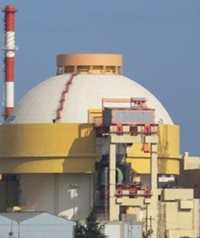IAEA slams India's lax nuclear safety regulations
27 Mar 2015
The International Atomic Energy Agency (IAEA), the United Nation's nuclear watchdog which concluded a review of India's nuclear safety regulations, has suggested that India's nuclear regulator, the Atomic Energy Regulatory Board (AERB), should strengthen its regulatory framework and follow an independent policy.
 A 12-day mission of IAEA's Integrated Regulatory Review Service (IRRS) that concluded today noted that the Indian nuclear regulator has vast research and development capabilities and the necessary infrastructure to follow strong regulatory review and assessment activities.
A 12-day mission of IAEA's Integrated Regulatory Review Service (IRRS) that concluded today noted that the Indian nuclear regulator has vast research and development capabilities and the necessary infrastructure to follow strong regulatory review and assessment activities.
However, the IRRS noted that India's nuclear regulator is not independent and lacks internal emergency arrangements.
In its preliminary findings, the IRRS team noted that India, which has projected a substantial increase in nuclear power generation over the next decade, faces challenges and that it must maintain sufficient regulatory oversight of both operating nuclear power plants and those under construction.
The UN nuclear watchdog has recommended that India should promulgate a national policy and strategy for safety, and radioactive waste management.
It also suggested that India's nuclear regulator should be independent and that it should be separated from other entities having responsibilities or interests that could unduly influence its decision making.
Besides, it suggested an increase in the frequency on-site inspections and development of internal emergency arrangements.
At the same time, the IRRS team noted that India has a comprehensive and well-established national educational and training system that supports competence-building for its nuclear programme and that the scope and depth of the AERB recruitment and training programme is effective in maintaining a knowledgable technical staff.
The AERB also takes full benefit from operational experience with the aim of continuously enhancing its regulatory framework and processes, it said, adding that its research and development infrastructure provided strong regulatory review and assessment activities,
IAEA has recommended that India's AERB should:
- Promulgate a national policy and strategy for safety, and a radioactive waste management strategy as a statement of the Government's intent;
- Embed the AERB's regulatory independence in law, separated from other entities having responsibilities or interests that could unduly influence its decision making;
- Review the implementation of its policy and existing arrangements to ensure it maintains independence in the performance of its regulatory functions;
- Consider increasing the frequency of routine on-site inspections at NPPs to allow for additional independent verification and more effective regulatory oversight; and
- Develop and implement its own internal emergency arrangements, including detailed procedures to fulfil its emergency response role.
- The IAEA is expected to provide the final mission report to the Indian government in about three months.
India has 21 operating nuclear power reactors and seven under construction. The review of other uses of nuclear materials and radioactive sources were not within the scope of this IRRS mission.
IRRS missions are designed to strengthen the effectiveness of the national nuclear regulatory infrastructure, while recognising the ultimate responsibility of each state to ensure nuclear safety. This is done through consideration of regulatory, technical and policy issues, with comparisons against IAEA safety standards, and, where appropriate, good practices elsewhere.
AERB chairman S S Bajaj, who received the IRRS draft report, said, "The acknowledgement of the effectiveness of India's safety regulation in the outcome of this IRRS mission has renewed AERB's resolve and commitment for ensuring a high level of safety in the facilities and activities. AERB is committed to pursuing the improvements suggested by the mission towards further strengthening the regulatory framework."
The Indian Government had invited the review, which included interviews and discussions with regulatory staff and site visits to observe inspections. The mission team compared the Indian regulatory framework for nuclear safety with IAEA safety standards.













.jpg)






.jpg)









